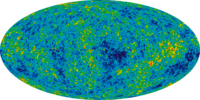
Photo from wikipedia
Technologies utilizing radiological materials across power generation, defence, industry, research and medicine have increased the global inventory of highly active and hazardous materials. Consequently, an amplified threat exists of illicitly… Click to show full abstract
Technologies utilizing radiological materials across power generation, defence, industry, research and medicine have increased the global inventory of highly active and hazardous materials. Consequently, an amplified threat exists of illicitly obtained materials being used as part of hostile acts. The potential for intentional releases occurs alongside risks from natural disasters or facility accidents. In any such event, it is crucial to rapidly assess the release composition and extent of response and remediation activities. Therefore, the deployment of an effective, resilient and autonomous radiation monitoring network is pivotal both during and after an incident. Underpinning this assessment is a detailed understanding of the pre-event or background, radiation levels, the knowledge of which is also essential in assessing a population’s dosimetric exposure to, and impact from anthropogenic and naturally occurring/varying sources of ionizing radiation. Presented here is a fully operational cloud-based spectroscopic radiation mapping platform comprising IoT modules compatible with cellular networks, without modification, in over 180 countries. Combined with locally roaming vehicles, a continuous multi-pass radiological characterization of an urban environment was performed. Such IoT devices are deployable as either individual sensors for specific localized temporal events or integrated over a greater time period (and area) to represent a larger static sensor. Over several months of continued operation, more than 1000 000 individual location-referenced gamma-ray spectra were collected and securely uploaded, in real-time, to an online cloud database and automatically characterized via a custom multi-step workflow. Fine-scale local variations in the radiological fingerprint of a 1 km × 1 km urban area were subsequently rendered in near-real-time to an interactive secure online graphical dashboard for temporal, spatial and spectral interrogation by the user. Considerations for the automated ‘elastic’ handling of ever-expanding volumes of input data have been carried out, facilitating propagation and expansion of the system’s database without human input.
Journal Title: Journal of Radiological Protection
Year Published: 2022
Link to full text (if available)
Share on Social Media: Sign Up to like & get
recommendations!